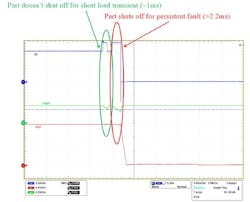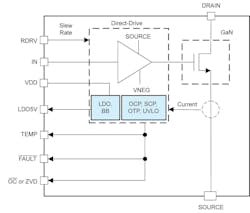Members can download this article in PDF format.
The proliferation of chatbots and other applications powered by artificial intelligence (AI) and machine learning (ML) is driving explosive growth in data centers and the power necessary to run them. Effectively powering these data centers requires innovative power-supply-unit (PSU) designs that incorporate reliable, resilient power modules, and protective circuitry.
Data Center Power Challenges
In a video chat, several leaders in Texas Instruments’ power-related businesses commented on the challenges involved in meeting data-center power requirements. Robert Taylor, sector general manager for power design services, said that a data-center server rack can consume between 150 and 200 kW. Kannan Soundarapandian, vice president and business-unit manager for high-voltage power, added that megawatt racks may be on the horizon: “A megawatt of power being consumed in the space of something that looks like a refrigerator—you cannot overstate it.”
Sponsored Resources:
- Power Data Centers: From the Grid to the Gate
- Power Modern AI Data Centers with Hot-Swap eFuses
- Dell 1.8kW Server PSU Powered by TI GaN
Priya Thanigai, vice president and business-unit manager for power switches, whose unit builds power-path protection products across multiple voltage rails, said she is seeing explosive growth in data-center business. The growing power demand is placing more emphasis on efficiency, redundancy, and zero downtime.
“All these challenges have always existed for the data center,” she said, “but now…the digital backbone of a hospital is a data center—that shifts the paradigm…. We are talking serious consequences if these power-hungry data centers aren’t designed right.”
The participants agreed that the days when data-center power requirements increased linearly and predictably are over, adding that chatbots and large language models (LLMs) have created a hockey-stick power-demand curve. Taylor said a conventional search can require 0.3 Wh of energy, whereas an LLM-based search requires 10X that amount, driving power requirements drastically upward.
“Look at the latest GPUs, each one sucking down about 2,000 A of current,” added Soundarapandian. “If you’re an electrical engineer, you know that is a staggering amount of current that has to be shoved through very tiny pieces of copper, and that has to happen continuously and be safe and reliable over 15 years.
A properly designed data center, said Soundarapandian, will also offer scalability—handling applications from posting an AI-generated video on social media to the management of decades of corporate engineering data. He added that the era of AI and ML represents the first time we as a species have a way to process noisy or improperly formulated information. “You throw data at [the server] and it does the work to make sense out of it. The power of that cannot be overstated.”
Designers are taking specific steps to address the growing power requirements. For example, Taylor said that because of thermal considerations, “We need to move the power supplies from the IT racks into what people are referring to as a sidecar,” adding that his team is developing custom reference designs for such new configurations.
Soundarapandian summed up the process of powering a data-center server: “There is a power path from where you plug in that server all the way down to the core.” Taylor elaborated, “We like to refer to this as the grid to the gate.” And Thanigai commented that the “grid-to-gate” phrase “encapsulates the exact problem”—how do you take the energy from the grid down to an individual gate on your GPU, losing as little as possible along the way.
High-Power Protective Devices
The power level increases cited by the video participants raise many challenges in managing large current levels while minimizing losses while maintaining reliability and safety. To help meet the challenges, TI offers a line of protective devices and gallium-nitride (GaN) FET modules for data-center PSU applications.
An example of these protective devices is the TPS1689 stackable integrated hot-swap eFuse device (Fig. 1), which includes fast, accurate current monitoring capability and a Power Management Bus (PMBus) interface to support digital telemetry. The device operates from 9 to 80 V, has 3.65-mW on-resistance, and features a 20-A current rating, with current limit adjustable from 2 to 20 A.
The TPS1689 facilitates power management without requiring external sense resistors and current amplifiers. TI said the device can reduce solution size up to 50% while enabling seamless scalability to support higher power levels.
A key feature of the TPS1689 is a blanking timer that enables users to optimize circuit performance and system protection. As shown in Figure 2 in green, the device will not shut down for short load transients, but as shown in red, it will shut down for persistent faults. Fault intervals are user-programmable to let designers tune their systems to match specific transient profiles.
GaN FET Modules
In addition to protective devices, TI also offers power stages for data-center PSUs. They include the LMG3522R050 (Fig. 3), which combines a GaN FET with a silicon driver in a package that minimizes gate-loop inductance to reduce switching losses. An adjustable drive-strength feature enables switching-speed slew rates from 15 to 150 V/ns, which allow designers to optimize switching performance while controlling electromagnetic interference.
To facilitate load management, the package reports device temperature through a variable duty-cycle pulse-width-modulation (PWM) output. The device also detects and reports overcurrent, short-circuit, and undervoltage-lockout faults. TI’s top-side-cooled package eases heatsink design and simplifies production, and its low thermal resistance to ambient improves dissipation.
Demonstrating the effectiveness of TI solutions in the data-center space, the LMG3522R050 is finding use in a Dell high-efficiency 1.8-kW PowerEdge server PSU, which derives a 12-V DC backplane voltage from an AC input. The PSU’s modular design makes it easy to remove or swap out. The LMG3522R050 enables Dell’s PowerEdge server PSU to achieve a system-level efficiency of better than 96%, sufficient for compliance with the 80 Plus Titanium standard for PSU efficiency.
Conclusion
The development of PSUs for data centers requires innovative engineering as well as efficient, reliable protective devices and power stages. As TI power business leaders explain in their video chat, Texas Instruments offers a full portfolio of products to carry energy from the grid to the gate.
Sponsored Resources:
- Power Data Centers: From the Grid to the Gate
- Power Modern AI Data Centers with Hot-Swap eFuses
- Dell 1.8kW Server PSU Powered by TI GaN



